23/02/22 - Long John Giovanni Tosco, almost 80, still in great form! -
Trial elixir of life? It is fair to wish it, since there are not a few elderly practitioners who testify that it is undoubtedly the least dangerous motorcycle discipline, capable of bestowing satisfaction on people of all ages .
A more than real example is that of the super pioneer of the Italian Trial, Giovanni Tosco from Turin, who will turn eighty this year! To say that it does not show them seems obvious and simplistic, judge for yourself by watching this video shot today: the sections in question are within the authorized area of Rubiana, village at the beginning of the Val di Susa, not far from Turin.
Tosco thrives on sport. Twice a week he plays tennis, and two or three times he goes to Rubiana to practice with his electric motorbike. At the end of January he participated in the intermediate route at the Mulatrial del Mare in Albenga, which lasted 6 hours, with another of his precious bike, a 2017 Gas Gas Racing GP. And in addition, garage boasts a collection of about forty specimens that represented milestones of his envied motorcycle career.
The Federation no longer allows him to obtain a license, because he has exceeded the age limit of 75, but he has found in the ASI Promotion Body the opportunity to get involved again and does not look bad at all, due to his innate predisposition to competitive sport.
This is its fifty-third year of activity in Trial, more than a golden wedding anniversary. He has left behind over a thousand competitions. He was the first Italian champion in the year in which it was officially established, the 1975, a title immediately replicated the following year. But even in previous years, he was already at the top, winner of the Italian Trophy in 1973 and 1974, when races were above all in Piedmont.
Nicknamed "Long John" due to his stature, he was the first official pilot of the Italian Trial, initially with the Borgarello company, the Ossa importer of Turin, then with SWM, strongly desired by Piero Kuciukian to develop and test the Guanaco 320 prototype, with which in 1981 French Giles Burgat gave the first world laurel to an Italian manufacturer.
Rebellious in not wearing gloves unless imposed by regulation (who knows if Bernie Schreiber was inspired by him?), he was also seen competing completely without sleeves. To those who ask him what pushed him to compete even today, he smilingly replies that he does it so as not to feel stoned!
For six months he has been equipped with a pacemaker but he jokes about it as you can hear in the video ...
After all, if the Trial discovered it at the age of 27, he will have to make up for lost time!
Giovanni, how did you get to the Trial?
“I've always liked motorcycles. As a young man I wheeled with the Vespa. A very dear friend, Gianfranco Mulatero in the 60s dragged me to the Gimkana competitions and to the Mountain-climbing. Then we heard that in San Pietro Val Lemina, (40 km from Turin) they were trying to organize a Triai race, it was 1969. There was a very bizarre point-counting system. We counted up to 5 for each supported foot, then each additional foot became a multiple of 5. We all had road bikes, modified for the occasion. I had adapted a Beta 160cc 2-stroke road to which I had even removed the front fender because there was no way to make it stay detached from the wheel "
But when did the first truly Trial bike arrive?
"A guy, Dario Pons from Pinerolo, often went to Spain and brought the latest news, in 1970, I bought a Montesa Cota 247, one of the first, the ones with large drum brakes."
And the Ossa?
“It was the Tosa company from Turin that let me try the MAR (Mick Andrews Replica) model the following year and I was immediately happy with it. I remember there was a competition, The Trial delle Nebbie (fog), in which Emilio Ostorero also took part, and I won. They talked about it in "La Stampa" (Turin main newspaper), the title was: - Turin employee beats motocross champion Emilio Ostorero! - "
What was the Trial in those days?
“Mainly it meant doing motorcycle mountaineering, or long laps on the mule tracks. The most serious races began in 1971, when the international regulations were adopted. That year Mulatero won, In 1972 Marini won, then since 1973 I've always won. Borgarello had rewarded me because I was also winning outside Piedmont. "
Where did they run outside the region?
“In Bergamo, perhaps they had started even before us. There was the Cassera Trophy. When foreigners arrived, there was no hope for us. I'll tell you an anecdote. It was 1973. On the eve of an International Trial, torrential rain came down. Gianfranco (Mulatero nda) and I decided to mount cross tires for the next day's race. I let you imagine on those slippery stones ... it was a disaster! ”
You always won in Piedmont, then when it began to be a national championship Pippo (Giuseppe Bartorilla) won the first challenge in Terni, how could this happen?
“There was a lot of balance. With Bartorilla, and Craviotto, we always trained together. Obviously I was hurt, but then I managed to catch up in the championship. "
What relationship was there with the importer?
“There was an excellent relationship with Mrs Borgarello (Ossa importer based in Turin). From 1973 until 1977 I was an official rider with them. It meant having two bikes, one for training and the other for racing. I had all the expenses paid and bonuses based on the results, but you couldn't live on it.
What was your job?
"I have always kept close to my job at ENEL,(National Electric Energy) even after - and luckily I did - when in SWM they wanted me full time to develop their bike. My Ossa, competition model, was checked by Luciano, the mechanic from Borgarello, first, then Piero Coscia and finally Giancarlo Bertani from 1976. "
It was said that the Ossa Bertani prepared had cylinder and piston from Bultaco, was it true?
"Yes it was very "inspired" by the Bultaco, even the exhaust was copied, As he himself admitted, it was a "photocopy" of the Bultaco!"
At that time Italians in the world championship were struggling to finish in the top 10, the first world point was brought home by "Teto" Fulvio Adamoli in Switzerland in 1977. Why this inferiority?
“They had tradition on their side. We only started seriously in 1974, they did at least ten years earlier ... "
How did your transition to SWM happen? Did they just want you as a rider or also as a developer of the bike?
“Dr. Piero Kuciukian wanted me, mainly to improve that bike by continuing to race. It was a great satisfaction to be able to win the world and Scottish in 1981 with Burgat ".
Epic feats were attempted in the Trial boom. Like the unfortunate one of climbing Kilimanjaro, but there was also something in China, wasn't it?
“In Africa we came close to the achievement, but then our permits were revoked and we had to go back. In China there was a demonstration in Beijing and also on the Great Wall. It was the Federation that organized. Corrado Buzzi was with me as Trial pilot. "
Has your wife Ida hindered or encouraged you in your career? You don't have any children, do you?
“No, she was always very understanding. We have no children. We have always been around, where we could with the camper, for my races. My wife has always supported me, she is my first fan! ”
How many races have you done in the world championship?
"I've done a lot of them. In Europe I've been almost everywhere. I've never gone to rehearsals overseas. I've done a lot with SWM. Also international races like Tres Dies del Cingles in Spain, which I preferred to the Scottish, for the less cold temperatures. I went to Scotland six times "
When did you stop racing at the highest level?
“The last year was 1985, when SWM failed. I was very upset. "
It coincides with your entry among the "gentlemen", the category reserved for riders of a certain age, right? Have you ever stopped being licensed?
“There was a period between 1985 and 1992 that I turned to tennis. I did a few laps on my motorbike and just the Samar Trophy races in val d'Aosta. "
What do you dislike about today's Trial?
"Indoor did not drive me crazy at the time, today there are often artificial obstacles or tight curves where you have to "hop". We are conditioned by enviromental prohibitions: not being able to go where you want has brought us to too technical trials. "
How do you see the new generations in the Trial?
“Young people often lack fundamentals. They hop the bike well, jump on rocks, then don't know how to set a bend on ground with poor grip. "
I remember you defined them with a nickname ...
"Yes, I call them the" sauta e bala "(in Piedmontese dialect it means jump and dance), because I often see useless and wasteful performances of energy, when to overcome an obstacle it would have been enough to know more about the technique of base. ”
What are the reasons for a decreasing number of fans?
"First of all the restrictions on the places where it is possible to practice, then also this exasperation of looking for increasingly difficult obstacles: young people must first of all have fun"
What could and should be done to resurrect?
“Hard to say. In my time, the moped was a fundamental goal for young people. Today it is no longer of interest except for rare exceptions ”
Your strength was concentration, I remember in the mythical duels with Teobaldi. Did that come naturally to you or did you have to work on it for a while?
“It's something that comes naturally to me, perhaps a natural gift. I never had to do anything to get there. ”
Are there any similarities with Tennis in the approach, such as doing well in a precise moment, immediately canceling a mistake and then restarting?
"Sure, but I play Tennis because I enjoy it and I need it to keep my legs in training"
The most pleasant memory?
"Maybe my second Italian title in 1976. It had been very close!"
Do you have any regrets? Something you wanted to do and didn't succeed?
"No, I think I did everything that could be done at the time"
What advice can you give to “sauta e bala”?
“Don't just think about jumping between boulders, but also learn how to set curves. There is someone who teaches both, Stefano Dellio who is following Thomas Bisaccia, a young man I often see shooting here, is one of them. "
photos courtesy of Giulio Mauri/Valenti Fontserè's archive or by Tosco FB profile
---------------------------------------------------------------------------------------
Giovanni Tosco, quasi ottantenne, ancora in ottima forma!
Trial elisir di lunga vita? E' giusto augurarselo, visto che non sono pochi i praticanti in età avanzata a testimoniare che si tratta indubbiamente della disciplina motociclistica meno pericolosa, capace di elargire soddisfazioni a persone di tutte le età.
Un esempio più che reale è quella del super pioniere del Trial italiano, il torinese Giovanni Tosco, che quest'anno compirà ottant'anni! Dire che non li dimostra ci sembra scontato e riduttivo, giudicate voi guardando questo video girato oggi: le zone in questione sono all'interno dell'area autorizzata di Rubiana, comune all'inizio della Val di Susa, non lontano da Torino.
Tosco vive di sport. Due volte alla settimana gioca a Tennis , e due o tre volte va a Rubiana per praticare con la sua moto elettrica. A fine gennaio ha partecipato nel percorso intermedio alla Mulatrial del Mare di Albenga, durata ben 6 ore, con un'altra delle sue preziose cavalcature una Gas Gas Racing GP del 2017 . Ed in più garage vanta una collezione di una quarantina di esemplari che hanno rappresentato pietre miliari della sua invidiata carriera motociclistica.
La Federazione non gli permette più di staccare una licenza, perchè ha superato l'età limite di 75 anni, ma lui ha trovato nell'Ente di Promozione ASI la possibilità di mettersi ancora in gioco e non sfigura affatto, vista la sua innata predisposizione allo sport agonistico.
Si tratta del suo cinquantatreesimo anno di attività col Trial, più che un anniversario di nozze d'oro. Alle spalle ha lasciato oltre mille competizioni. E' stato il primo campione italiano nell'anno in cui fu ufficialmente istituito, il 1975, titolo immediatamente replicato l'anno successivo. Ma anche negli anni precedenti, era già ai vertici, vincitore del Trofeo Italia nel 1973 e 1974, quando si correva soprattutto in Piemonte.
Soprannominato “Long John” per la sua statura, è stato il primo pilota ufficiale del Trial italiano, all'inizio con l'importatore Ossa di Torino, la ditta Borgarello, poi con la SWM, fortemente voluto da Piero Kuciukian per sviluppare e testare il prototipo Guanaco 320, con il quale nel 1981 il francese Giles Burgat regalò il primo alloro mondiale a un costruttore italiano.
Ribelle nel non indossare i guanti se non quando imposto dal regolamento (chissà se Bernie Schreiber si è ispirato a lui? ) , si è anche visto gareggiare completamente senza le maniche. A chi gli chiede cosa lo spinge a correre ancora oggi, lui sorridendo risponde che lo fa per non sentirsi rimbambito!
Da sei mesi ha in “dotazione” un pacemaker ma lui ci scherza sopra come potete ascoltare nel video …
Del resto se il Trial lo ha scoperto a 27 anni, dovrà pur recuperare il tempo perso!
Giovanni, come sei arrivato al Trial?
“Le moto mi sono sempre piaciute. Da giovane impennavo con la Vespa. Un carissimo amico, Gianfranco Mulatero negli anni '60 mi trascinò alle gare di Gimkana e alle Motoscalate. Poi venimmo a sapere che a San Pietro Val Lemina,(40 km da Torino) stavano provando a organizzare una gara di Triai, era il 1969. C'era un sistema di conteggio punti molto bizzarro. Si contava fino a 5 per ogni piede appoggiato, poi ogni piede in più diventava un multiplo di 5. Avevamo tutti delle moto da strada, modificate per l'occasione. Io avevo adattato una Beta 160cc 2 tempi stradale a cui avevo perfino tolto il parafango anteriore perchè non c'era modo di farlo stare staccato dalla ruota”
Ma la prima moto veramente da Trial, quando arrivò?
“Un tipo, Dario Pons di Pinerolo, andava spesso in Spagna e portava le ultime novità, nel 1970, acquistai una Montesa Cota 247, delle prime, quelle coi ceppi grossi.”
E l'Ossa ?
“Fu la ditta Tosa di Torino che mi fece provare il modello MAR (Mick Andrews Replica) l'anno successivo e mi trovai subito bene. Mi ricordo ci fu una gara, Il Trial delle Nebbie, a cui partecipò anche Emilio Ostorero, e vinsi io. Ne parlarono su “La Stampa”, il titolo fu: -impiegato torinese batte il campione di motocross Emilio Ostorero!-”
Cos'era il Trial a quei tempi?
“Principalmente significava fare motoalpinismo, ovvero lunghi giri sulle mulattiere. Le gare più serie sono iniziate nel 1971, quando si adottò il regolamento internazionale. Quell'anno vinse Mulatero, Nel 1972 vinse Marini, poi dal 1973 ho sempre vinto io. La Borgarello mi aveva premiato perchè vincevo anche fuori dal Piemonte.”
Dove si correva fuori dalla regione?
“A Bergamo, forse avevano iniziato anche prima di noi. C'era il Trofeo Cassera. Quando arrivavano gli stranieri per noi non c'erano speranze. Ti racconto un aneddoto. Era il 1973. Al sabato di un Trial Internazionale venne giù una pioggia torrenziale. Io e Gianfranco (Mulatero nda) decidemmo di montare gomme da cross per la gara del giorno dopo. Ti lascio immaginare su quelle pietre... fu un disastro!”
Vincevi sempre in Piemonte, poi quando iniziò a essere un campionato nazionale Pippo (Giuseppe Bartorilla) si aggiudicò la prima sfida di Terni, come poté accadere?
“C'era molto equilibrio. Con Bartorilla, e Craviotto, ci allenavamo sempre insieme. Ovvio che ci rimasi male, ma poi nel campionato riuscii a recuperare.”
Che rapporto c'era con l'importatore?
“Con la signora Borgarello ( importatore Ossa con sede a Torino) c'era un ottimo rapporto. Dal 1973 fino al 1977 sono stato pilota ufficiale con loro. Voleva dire avere due moto, una per l'allenamento e l'altra per la gara. Avevo tutte le spese pagate e dei premi in base ai risultati, ma non ci potevi vivere.
Che lavoro svolgevi?
"Io mi sono sempre tenuto stretto il mio impiego all'ENEL, anche dopo – e per fortuna l'ho fatto – quando in SWM mi avrebbero voluto a tempo pieno per sviluppare la loro moto. La mia Ossa da gara la sistemava Luciano, il meccanico di Borgarello, prima, poi Piero Coscia e infine Giancarlo Bertani dal 1976.”
Si diceva che le Ossa che preparava Bertani avessero cilindro e pistone del Bultaco, era vero?
“Sì era molto “ispirata” ai Bultaco, anche lo scarico era stato copiato, Come ammetteva lui stesso, era una “fotocopia” del Bultaco!”
Allora gli italiani al mondiale faticavano a finire nei primi 10, il primo punticino mondiale lo portò a casa il “Teto” Fulvio Adamoli in Svizzera nel 1977. Come mai questa inferiorità?
“Avevano la tradizione dalla loro. Noi siamo partiti seriamente soltanto dal 1974, loro almeno dieci anni prima...”
Come avvenne il tuo passaggio in SWM? Ti vollero solo come pilota o anche sviluppatore della moto?
“Mi aveva contattato il dott. Piero Kuciukian, principalmente per migliorare quella moto, continuando a correre. Fu una grande soddisfazione arrivare a vincere mondiale e Scottish nel 1981 con Burgat”.
Nel boom del Trial si tentarono imprese epiche. Come quella sfortunata di salire sul Kilimangiaro, ma ci fu anche qualcosa in Cina vero?
“In Africa arrivammo vicini all'impresa, ma poi i permessi ci furono revocati e dovemmo tornare indietro. In Cina ci fu una dimostrazione a Pechino e anche sulla Grande Muraglia. Fu la Federazione a organizzare. Come piloti di Trial insieme a me c'era Corrado Buzzi.”
Ida, tua moglie ti ha ostacolato o incoraggiato nella tua carriera? Non avete figli vero?
“No lei è stata sempre molto comprensiva. Non abbiamo figli. Siamo sempre stati in giro, dove potevamo col camper, per le mie gare. Mia moglie mi ha sempre sostenuto, è la mia prima tifosa!”
Quante gare hai fatto nel mondiale?
"Ne ho fatte parecchie. In Europa sono stato un po' ovunque. Non sono mai andato alle prove oltre oceano. Ho girato molto con l'SWM. Anche gare internazionali come la Tres Dies del Cingles in Spagna, che preferivo alla Scottish, per le temperature meno rigide. In Scozia sono andato sei volte"
Quando smettesti di correre al massimo livello?
“L'ultimo anno fu il 1985, quando fallì l'SWM. Ci rimasi molto male."
Coincise con la tua entrata fra i “gentlemen” , la categoria riservata a piloti di una certa età, giusto? Non hai mai smesso di avere la licenza?
“C'è stato un periodo fra il 1985 e il 1992 che mi sono dato al Tennis. Facevo qualche giro in moto e giusto le gare del Trofeo Samar in val d'Aosta.”
Cosa invece non ti piace del Trial dei giorni nostri?
"Gli indoor non mi facevano impazzire già all'epoca, oggi spesso ci sono ostacoli artificiali o curve strette dove si deve “spostare”. Si è condizionati dai divieti: il non poter andare dove si vuole ci ha portato a trial troppo tecnici."
Come vedi le nuove generazioni nel Trial?
“Ai giovani spesso mancano i fondamentali. Spostano bene la moto, saltano su pietroni, poi non sanno impostare una curva su terreno con scarsa aderenza.”
Mi ricordo che li avevi definiti con un appellativo...
“Sì io li chiamo i “sauta e bala” (in dialetto piemontese significa salta e balla), perchè spesso vedo esibizioni inutili e dispendiose di energie, quando per superare un ostacolo sarebbe bastato conoscere di più la tecnica di base.”
Quali sono i motivi di un calante numero di appassionati?
“In primis le restrizioni sui luoghi dove è possibile praticare, poi anche questa esasperazione di cercare ostacoli sempre più difficili: i giovani devono innanzitutto divertirsi”
Cosa si potrebbe e dovrebbe fare per risorgere?
“Difficile dirlo. Ai miei tempi per i giovani il motorino era un traguardo fondamentale. Oggi non interessa più se non a rare eccezioni”
La tua forza è stata la concentrazione, ricordo nei mitici duelli con Teobaldi. E' una cosa che ti veniva naturale o hai dovuto lavorarci un po'?
“E' qualcosa che mi viene spontanea, forse una dote naturale. Non ho mai dovuto fare nulla per arrivarci.”
Ci sono delle similitudini col Tennis nell'approccio, tipo fare bene in un preciso momento, cancellare immediatamente un errore e poi ripartire?
“Sicuramente, ma io gioco a Tennis perchè mi diverto e mi serve per tenere le gambe in allenamento”
Il ricordo più piacevole?
“Forse il mio secondo titolo italiano nel 1976. Era stato molto combattuto!”
Hai qualche rimpianto? Qualcosa che avresti voluto fare e non ci sei riuscito?
“No, credo di aver fatto tutto quello che si poteva fare all'epoca”
Che consiglio puoi dare ai “sauta e bala” ?
“Non pensare solo a saltare fra un masso e l'altro, ma imparare anche come si impostano le curve. C'è qualcuno che insegna entrambe le cose, Stefano Dellio che sta seguendo Thomas Bisaccia, un giovane che vedo sovente girare qui, è uno di questi.”
------------------------------------------------------------------------------------------
------------------------------------------------------------------------------------------
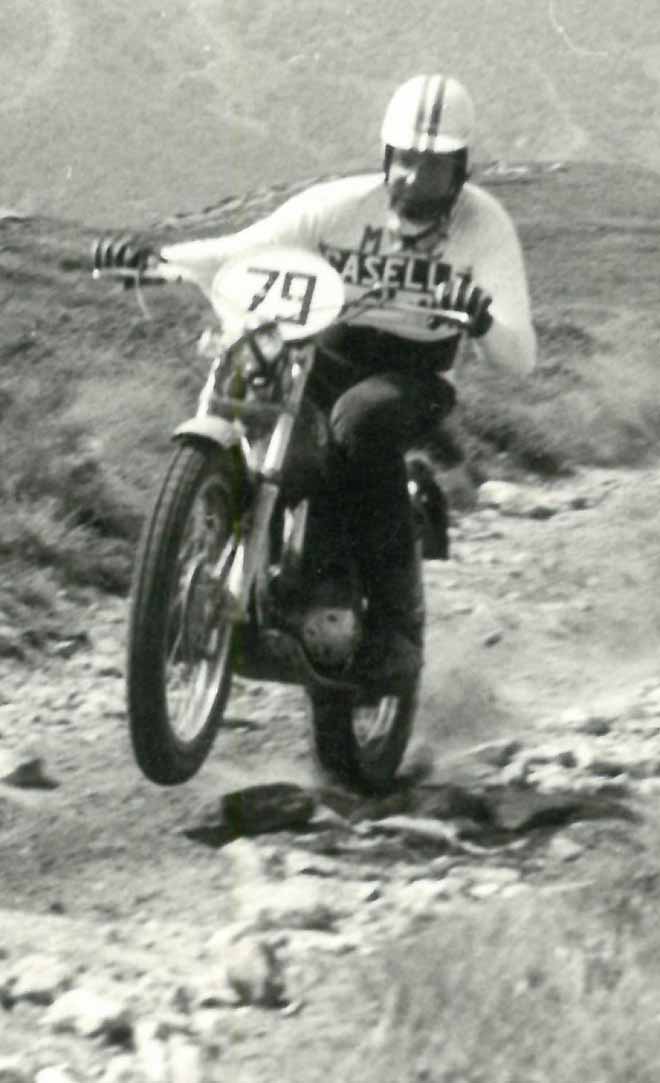
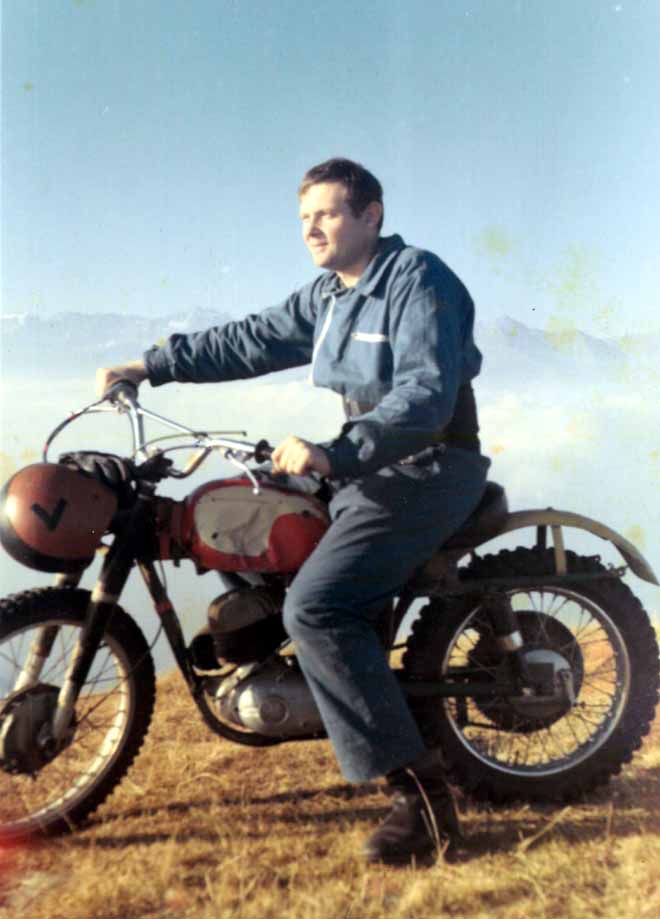
When Trial was not known yet, here is riding a Beta 160 on a sort of mountain-climbing-race
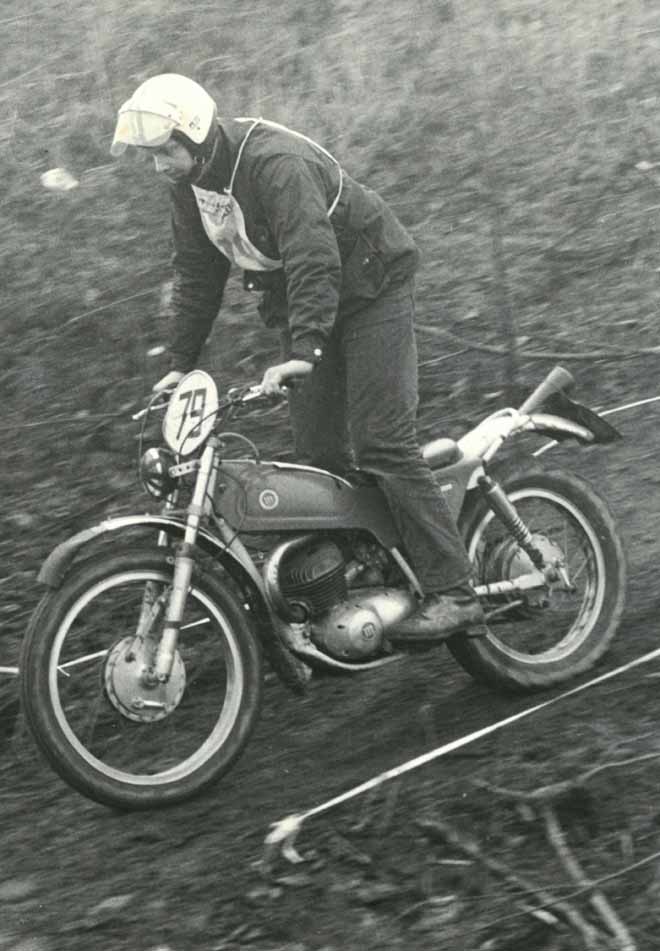
Riding his first Trial bike: Montesa 247, in 1971
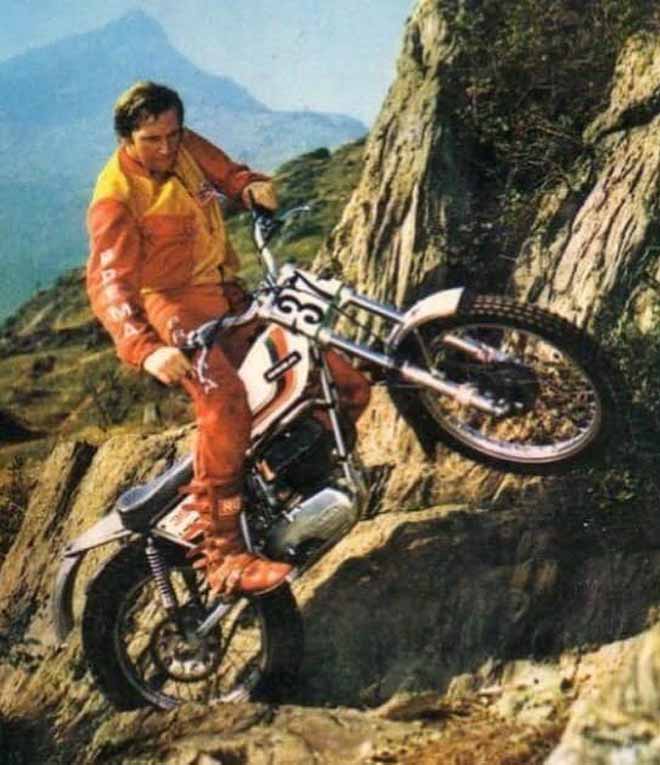
Two Italian titles won riding Ossa, in 1975 and 1976
.jpg) Riding SWM Guanaco 320, he developed and tested for the factory
Riding SWM Guanaco 320, he developed and tested for the factory 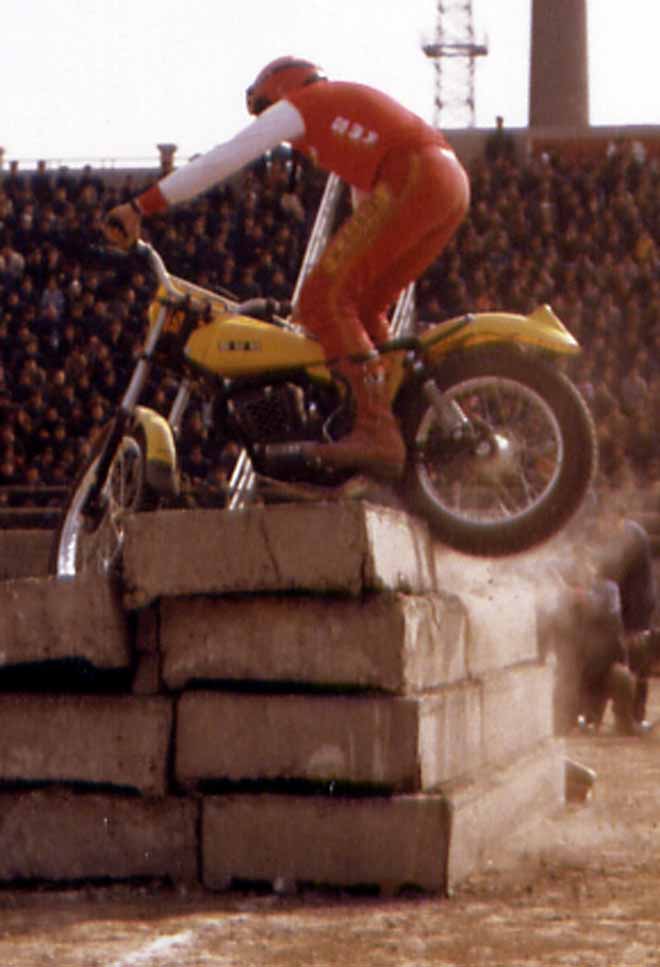
When official rider for SWM, in China, indoor in Pechino
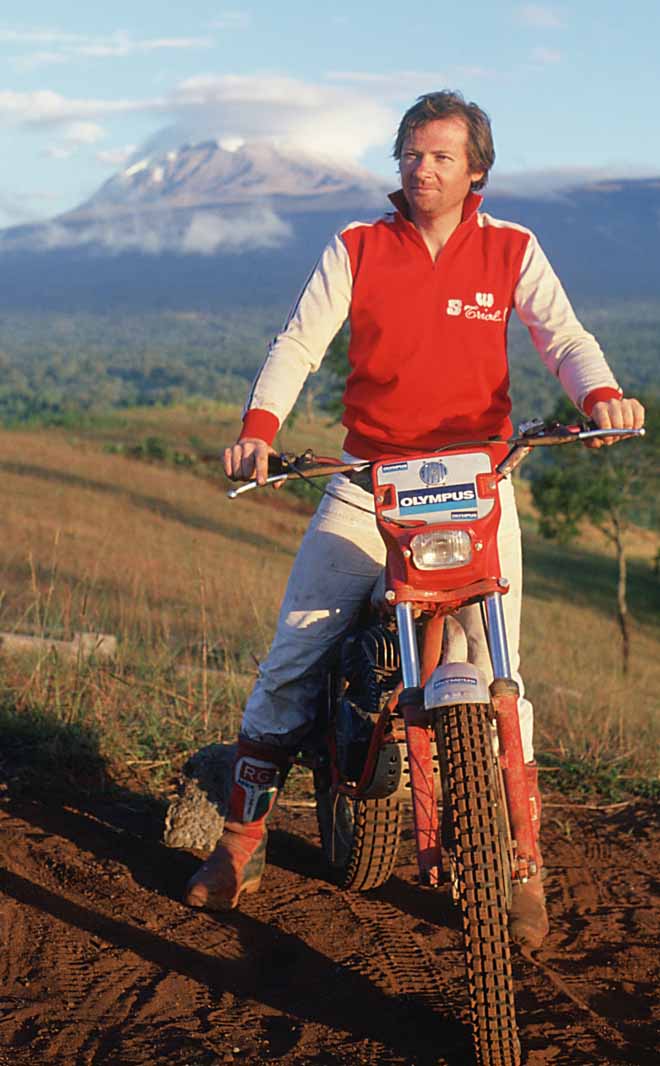
Still with SWM in Africa, behind him the Mt. Kilimangiaro
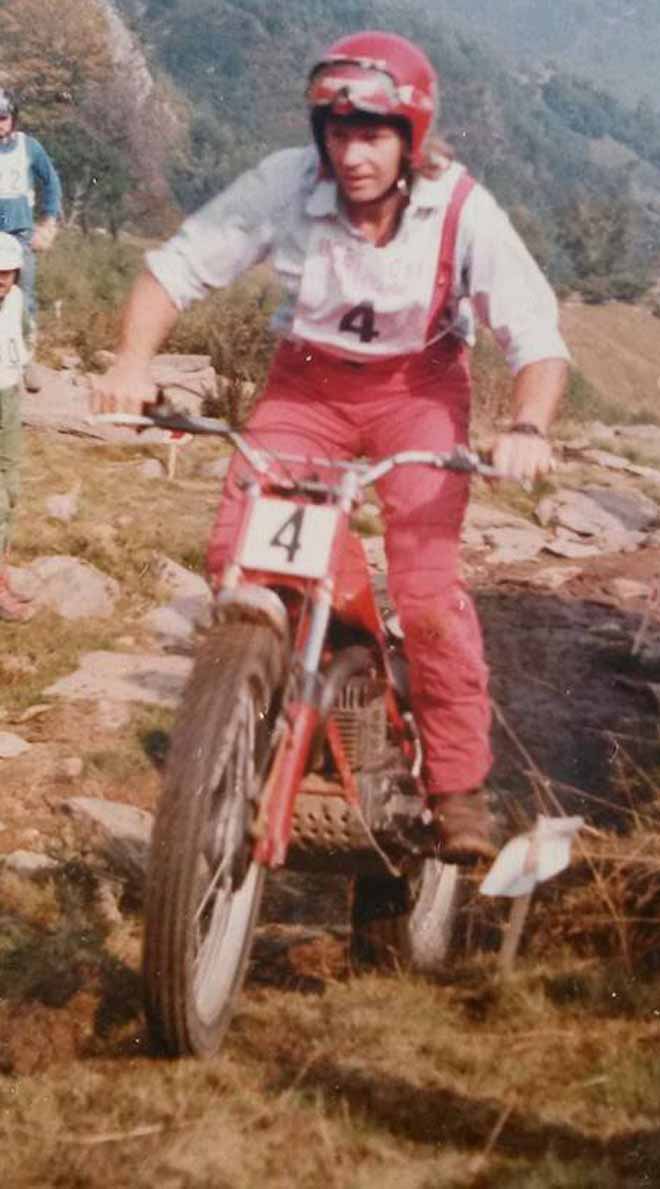
Italian championship in 1978
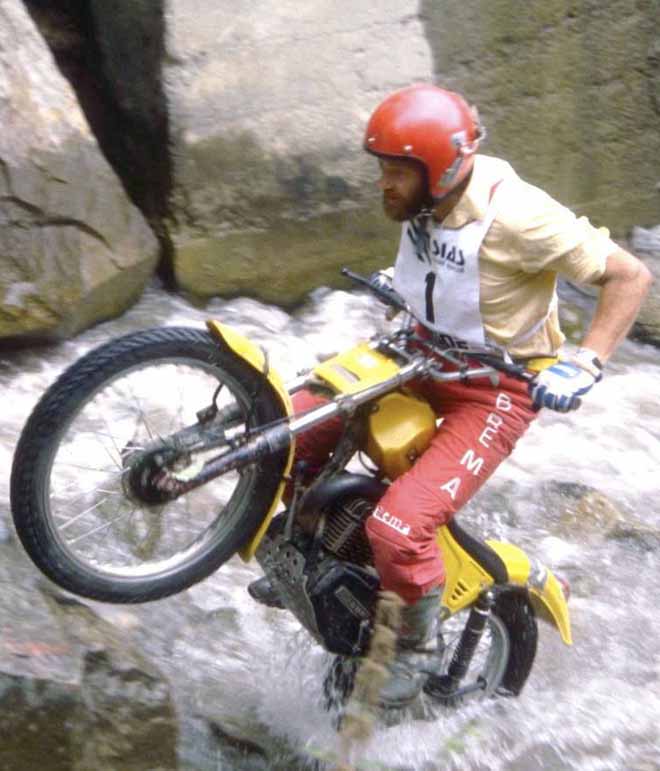
Italian championship in 1980
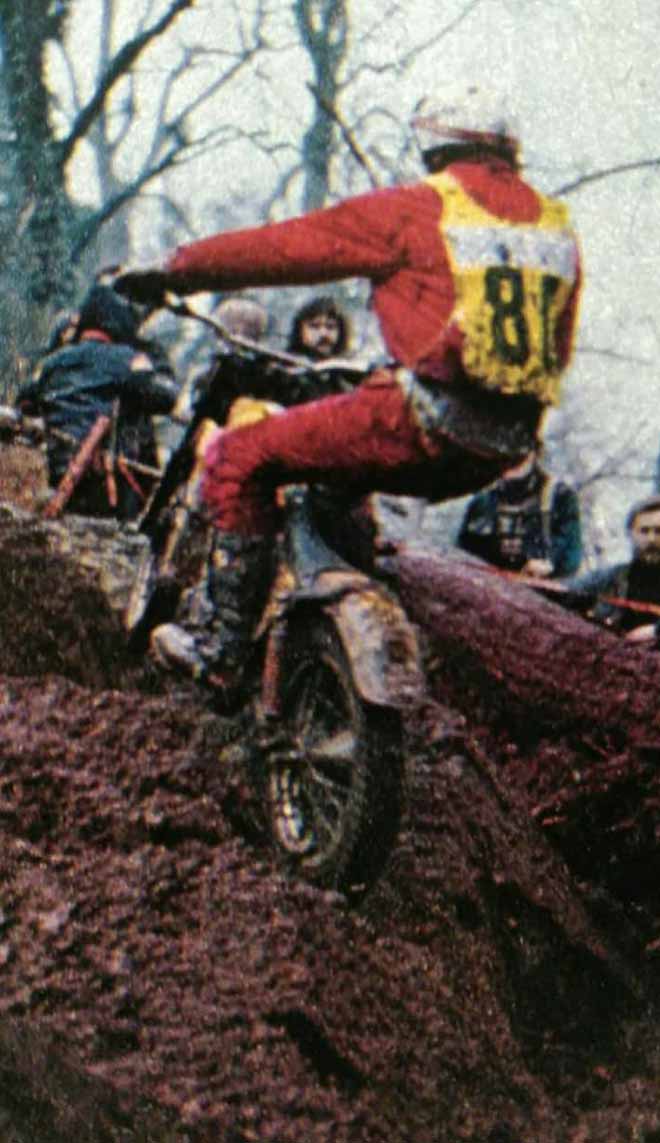
1980, Ireland, World Championship
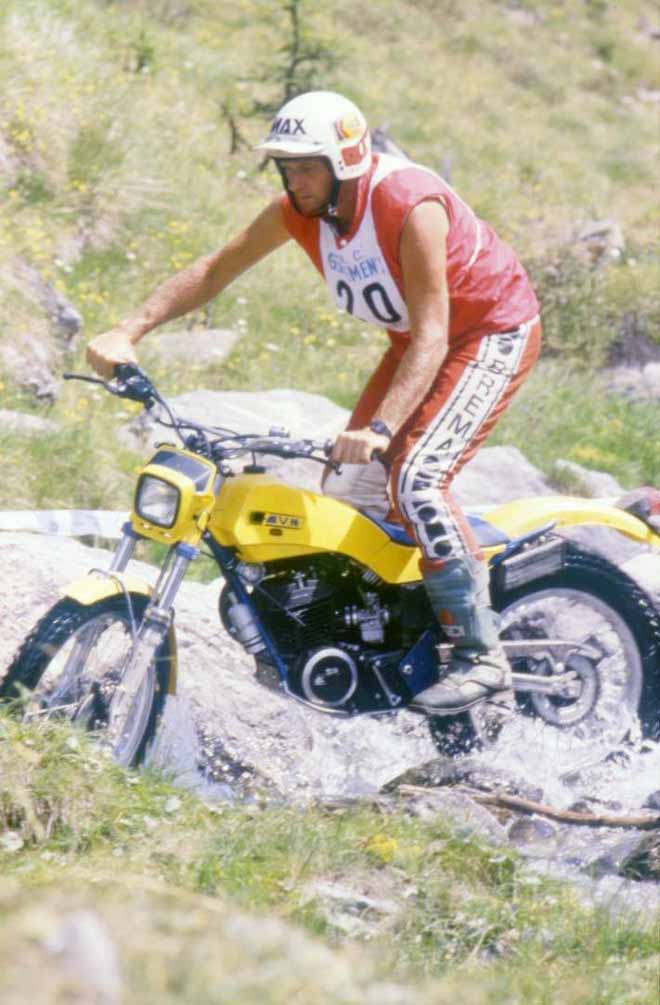
1982, Regional champ, no sleeves!
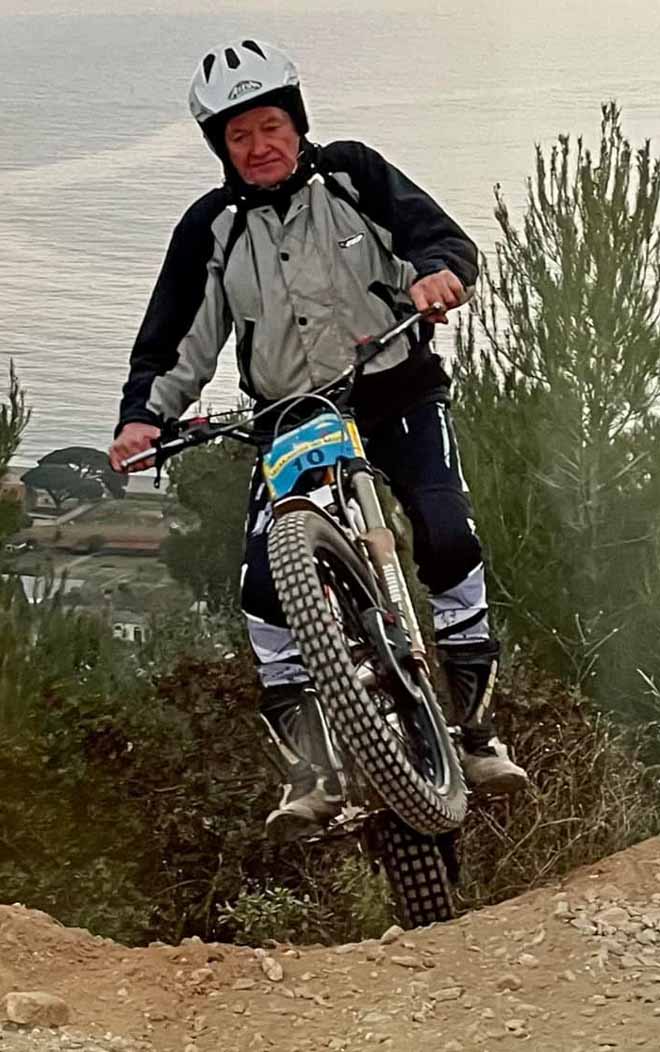
2022 Mulatrial del Mare
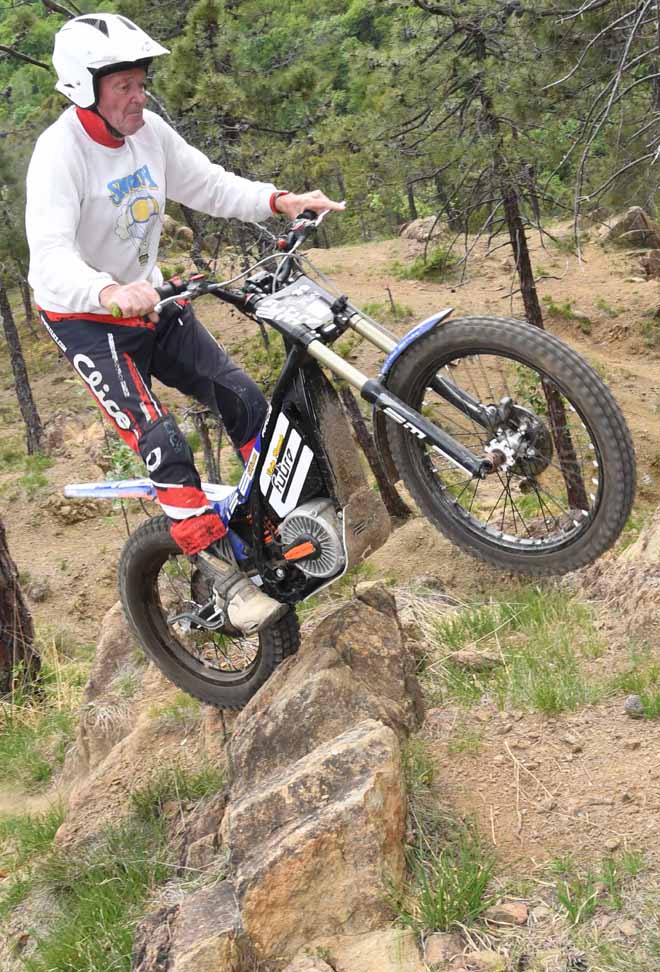
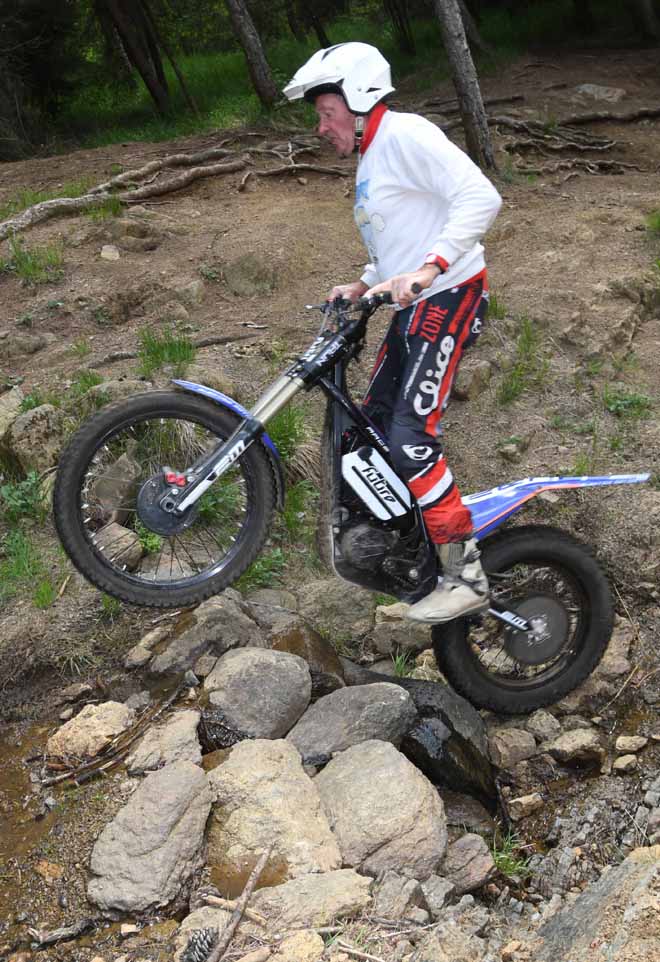
2022 Rubiana training
---------------------------------------------------------------------------------------

